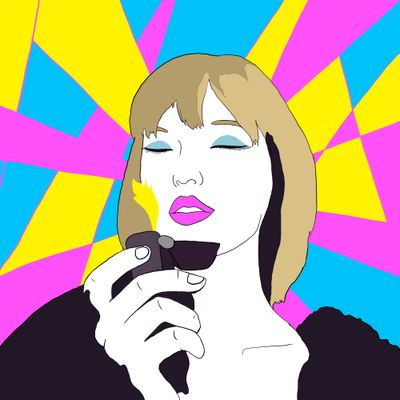
A Taylor Swift album is just not a collection of new music, it’s an exploration of a theme. For the last eight years, each release has embodied a single idea. Reputation marked a turn to the dark side, Lover a return to the light, and her pair of albums folklore and evermore painted acoustic, fictional landscapes. Midnights, Swift’s tenth and most recent project, builds a lyrical and sonic nocturne. Each album propels fans to find covert lyrical connections to her personal life and Easter eggs to past compositions.
On Midnights, Swift and her frequent producing partner (and friend of the show) Jack Antonoff create the album’s connection to late-night dance and club sounds through the aid of a particular synth patch — we can even connect “Lavender Haze” to genres like techno, U.K. garage, and jungle. In this episode of Switched on Pop, Nate and Charlie listen closely to hear how Swift constructs this after-hours feeling with help from John Hull, a producer for and instructor at the online music school Soundfly. Read their conversation below and listen to the whole episode wherever you get your podcasts.
Switched on Pop
Subscribe on:
Charlie Harding: Let’s talk about the different soundscapes that we’re hearing. You can hear all kinds of Jack Antonoff’s retro-synth sequences throughout the album, like in “Mastermind” or in “Bejeweled.”
All these retro-synth sounds are supported by down-tempo dance rhythms like we heard on “Lavender Haze.” If there’s one through-line on this record, it’s the bass sound. Do you know what that’s called?
Nate Sloan: It’s called … a sludge thunder bass?
CH: Close. It’s called a “Reese bass.”
John Hull: A Reese bass is a synth-bass sound that typically characterizes a very low, almost boiling bass patch that adds an air of discomfort to whatever it accompanies. It was first created by Kevin “Reese” Saunderson in 1988 for his track “Just Want Another Chance.”
However, Saunderson wasn’t really recognized for it. It was actually a track from 1994 by the U.K. artist Ray “Renegade” Keith that put it on the map, when he sampled Saunderson in his song “Terrorist.”
From there, it became a sort of quintessential element of the jungle and drum-and-bass sound. You can also notably hear it in Burial’s “Archangel.”
CH: That Reese bass has become a mainstay in pop music. It’s not unusual to hear that particular bass sound, but it is all over Midnights, from “Question …?” to “Anti-Hero” to “Karma” and everything in between. For me, it connects the world of Midnights to the dance genres that originated this sound. It makes these songs feel like late-night club tracks, even though many of the beats are down-tempo.
NS: This is very illuminating; I was hearing that bass sound, but I didn’t know what to call it. I wasn’t even sure if I was, like, a little nuts for thinking that it was throughout this album. Can I throw out a perhaps obtuse analogy here?
CH: Of course.
NS: I think Reese bass is sort of equivalent to the sandworms in Dune. It’s under the surface; you almost don’t really hear it clearly, you only see the sand moving. You only get a sort of hint of what that creature — that sound — might look like. You get the sense that if you turn up your speakers to hear the bass more clearly, you still wouldn’t be able to. It’s always a little bit out of reach. Maybe it’s something about the way it’s filtered or side-chained … I don’t know. But something about it is untouchable; it’s unreachable.
CH: It’s subterranean. It’s dark.
NS: The bass is sort of there but also not. I feel like that’s a metaphor for many of the themes on this album: being up in the middle of the night trying to catch a fragment of a dream you had, trying to re-create a half-lost memory.
This excerpt has been edited and condensed.

